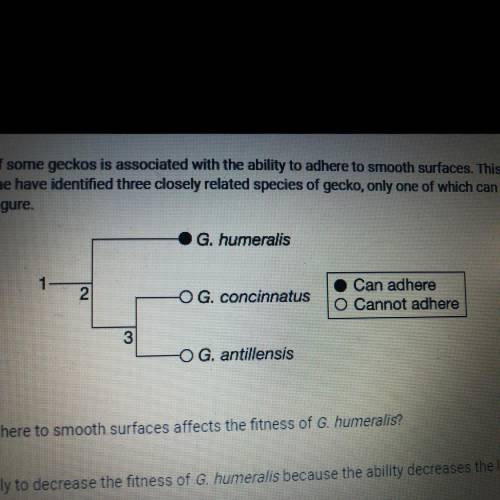
Biology, 22.02.2021 18:30 EllaLovesAnime
Which of the following best describes how the ability to adhere to smooth surfaces affects the fitness of G. humeralis?
A
The ability to adhere to smooth surfaces is likely to decrease the fitness of G. humeralis because the ability decreases the likelihood of predation.
B
The ability to adhere to smooth surfaces is likely to decrease the fitness of G. humeralis because the ability increases the likelihood of predation.
С
The ability to adhere to smooth surfaces is likely to increase the fitness of G. humeralis because the ability decreases the likelihood of predation,
D
The ability to adhere to smooth surfaces is likely to increase the fitness of G. humeralis because the ability increases the likelihood of predation.


Answers: 3


Other questions on the subject: Biology

Biology, 21.06.2019 20:00, zaratayyibah
Researchers randomly divide participants into groups. each group takes a different amount of omega-3 fatty acid supplements daily for a month. one group receives a placebo. the researchers measure the impact on cholesterol levels in the blood. what is the purpose of random assignment in this experiment? a, to produce treatment groups with similar characteristics b, to ensure that all people with high cholesterol have an equal chance of being selected for the study c, to increase the accuracy of the research results and prevent skewness in the data
Answers: 1


Biology, 22.06.2019 02:00, Bashirar19
The united states produces an average of 429 billion pounds of food annually. about 133 billion pounds of that food ends up as waste. the percentage of food that the united states wastes each year is %.
Answers: 2

Biology, 22.06.2019 06:00, nauticajanke03
The empty trna moves off and picks up another matching amino acid from the cytoplasm in the cell. the anticodon of the trna, with its attached amino acid, pairs to the codon of the mrna, which is attached to a ribosome. this sequence is repeated until the ribosome reaches a stop codon on the mrna, which signals the end of protein synthesis. the ribosome forms a peptide bond between the amino acids, and an amino acid chain begins to form. when a second trna with its specific amino acid pairs to the next codon in sequence, the attached amino acid breaks from the first trna and is bonded to the amino acid of the second trna.
Answers: 1
You know the right answer?
Which of the following best describes how the ability to adhere to smooth surfaces affects the fitne...
Questions in other subjects:

Mathematics, 03.06.2021 20:00

Mathematics, 03.06.2021 20:00





Mathematics, 03.06.2021 20:00

English, 03.06.2021 20:00

Chemistry, 03.06.2021 20:00



